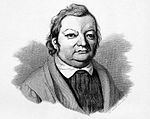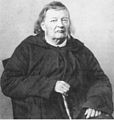Anton Duttenhofer
Anton (Raphael) Duttenhofer (born October 19, 1812 in Stuttgart , † February 11, 1843 in Stuttgart) was a German engraver . Only a few works, mostly engravings based on other people's models, have survived by the artist, who died early.
Life
Anton Duttenhofer was born on October 19, 1812 in Stuttgart as the son of the copper engraver Christian Friedrich Traugott Duttenhofer and the silhouette artist Luise Duttenhofer, born. Bumblebee born. Of the parents' three children who reached adulthood, he was the youngest. His sister Marie (1807–1839) married the Öhringen lawyer Christian Friedrich August Tafel (1798–1856), and his older brother Friedrich Martin became a government equine doctor and professor.
Education
Duttenhofer learned the beginnings of engraving from his father and enrolled at the age of 16 on November 21, 1828 at the Academy of Fine Arts in Munich for the subject of engraving. How long he studied there is not known. The copperplate engraving was taught by Samuel Amsler and Carl Hess . History painting was represented by Peter von Cornelius , Heinrich Maria von Hess , Moritz Kellerhoven , Julius Schnorr von Carolsfeld and Clemens von Zimmermann .
At the academy, Duttenhofer had the opportunity to come into contact with many other students from Württemberg, some of whom he certainly already knew. Heinrich Leibnitz , who also came from Stuttgart and who later made a career as a painter and became a university drawing teacher and professor of art history at the University of Tübingen , matriculated with him on the same day . The later history painter Ferdinand Alexander Bruckmann (1806-1852) also studied at the academy during these years. He had taken engraving and modeling lessons from his Heilbronn cousin Peter Bruckmann at the beginning of the twenties and certainly already got to know the young Duttenhofer, whose parents were friends with Peter Bruckmann. One can assume that at the academy he also met the painters Moritz von Schwind and Wilhelm von Kaulbach , who later became famous, and who were studying there at the same time.
Life in Stuttgart
After completing his academic training, Duttenhofer settled in Stuttgart and acquired the reputation of an excellent scene and portrait engraver. He was friends with the painter German von Bohn , who like his father came from Heilbronn and whom he portrayed in a drawing in 1835 (see works). Christian Duttenhofer lived in Heilbronn again from 1834. When his son visited him, he sometimes went with him to Justinus Kerner in the Kernerhaus in Weinsberg . On such an occasion he also created a portrait of the poet-doctor, with which he was not at all satisfied (see works). In 1841 he made a trip to Italy, about which nothing further is known.
On February 11, 1843, Duttenhofer died at the age of only 31 in Stuttgart "as a result of a fever". He lost his mother in 1829 when he was seventeen, and his father survived him by three years. Nothing is known about Duttenhofer's grave.
Works
Spring nymph after Eberhard Wächter (1833–1843)
Literature: Gauss 1976.
Pencil drawing on brownish laid paper, after a painting by Eberhard Wächter , sheet size: 37.5 × 29.3 cm, date of origin 1833–1843, Staatsgalerie Stuttgart, Graphic Collection, inventory number C 1924/125. Label on the back: “Drawing by Anton Duttenhofer after a painting by Eberhard Wächter owned by Peter Bruckmann in Heilbron / By Dr. Ms. Duttenhofer received as a gift as a souvenir to his brother Anton in February 1843. “Nothing is known about the whereabouts of the painting by Eberhard Wächter.
A young woman with a Greek profile and classic hairstyle, dressed in an antique robe and bare back turned to the viewer, sits sideways on a boulder and, supported on her bent right arm, lets water flow down from a bulbous vase.
German von Bohn (1835)
Literature: Fleischhauer 1939.
Portrait of the painter German von Bohn , drawing, year of creation 1835, dimensions and location unknown.
Werner Fleischhauer found that Anton Duttenhofer “portrayed his friend Bohn in 1835 in a wonderfully delicate drawing that was completely on the line, full of a classic sense of form and almost romantic spirituality”.
Friedrich Haug after Johann Heinrich Dannecker (1840)
| Literature: Haug 1840; Holst 1987, pp. 363-364; NN 2010.
Portrait of the poet Friedrich Haug , copper engraving after a plaster relief medallion by Johann Heinrich Dannecker , year of origin 1840, frontispiece to Haug 1840. Description: “JCF HAUG. After Dannecker's bas-relief engraved by A [nton] Duttenhofer ”. The German Literature Archives Marbach owns two of three known copies of Dannecker's plaster medallion, the third copy, formerly in the possession of the Staatsgalerie Stuttgart, seems to have been lost. The medallion depicted in a press release from the literature archive (NN 2010) does not match the copperplate engraving. |
Romeo and Julie after Alexander Bruckmann (1841)
Literature: NN 1842.
Scene from William Shakespeare's " Romeo and Juliet ", copper engraving after a painting by Ferdinand Alexander Bruckmann , Royalfolio (20 × 12 inches), year of creation 1841, location unknown. The engraving was distributed to its members by the Württembergischer Kunstverein as a gift.
On the engraving, Romeo's farewell to Juliet is shown in the 5th scene of the 3rd act: “Farewell, farewell! one kiss, and I'll descend. ”(Goodbye, goodbye, one kiss and I'll descend). The art paper of the Morgenblatt for educated estates from 1842 said: “[The sheet] testifies to the courage of the young artist to reproduce a difficult light effect with the grave mark. The first glimmer of dawn shines on the horizon and the pale moon is still in the night sky when Romeo grabs the rope ladder and presses the last kiss on the beloved's mouth. "
Justinus Kerner (1841)
Literature: Fleischhauer 1939, NN 1841.
Portrait of the poet-doctor Justinus Kerner , drawing and lithograph, year of creation 1841, dimensions and location unknown.
The drawing and the lithograph show Kerner at the age of around 55. The painting shown for comparison portrays Kerner, who is around 66 years old, and the photograph was taken a few years before his death (Kerner died at the age of 75). The art paper of the Morgenblatt for educated estates from 1842 found that the portrait was engraved “with a simple and soft structure, but full of character”. It is “similar, and well modeled, and especially the expression of the eyes is as true to life as their treatment is artistically perfect.” Werner Fleischhauer judged the drawing: “A lithograph by Justinus is kept in strong and strong plastic, but internally empty forms Kerner, who also wrote a characteristic remark about these pictures: "Pumpkin head" [pumpkin head] ". Kerner was apparently dissatisfied with the drawing, so that there was probably a dispute with Duttenhof's father and son, because Julie Hartmann wrote to him on February 28, 1841: “The story with your picture, etc. Duttenhofer's unheard-of presumptuousness interested us all very much. [...] We just want to be glad that you are not presented to the world as a caricature. "
Cosimo I. de 'Medici after Agnolo Bronzino
Literature: NN 1914.
Engraving after the painting Portrait of Cosimo I de 'Medici (1545) by Agnolo Bronzino .
literature
- Academy of Fine Arts Munich, matriculation database
- Joseph Heller, Andreas Andresen, Joseph Edward Wessely: Handbook for copper engravers . tape 1 . TO Weigel, Leipzig 1870, p. 415 ( online ).
- Conversation lexicon for visual arts . Romberg, Leipzig 1846, p. 312 ( online ).
- Werner Fleischhauer : The portrait in Württemberg 1760-1860. History, artists and culture. Metzler: Stuttgart 1939, p. 216.
- Ulrike Gauss (editor): The drawings and watercolors of the 19th century in the graphic collection of the Staatsgalerie Stuttgart. Inventory catalog up to December 1975 , Stuttgart 1976, p. 41.
- Friedrich Haug: Poems: With the portrait of the author . Ebner & Seubert, Stuttgart 1840, frontispiece ( online ).
- Christian von Holst: Johann Heinrich Dannecker, Part 1: The Sculptor. Stuttgart 1987.
- Manfred Koschlig: Arcadia is here too. News from Madame Duttenhofer's wonderful scissors. In: Librarium. 10.1967, pp. 124-147.
- Friedrich Mueller: Duttenhofer, Anton . In: The artists of all times and peoples . tape 1 . Ebner & Seubert, Stuttgart 1857, p. 534 ( online ).
- Heilbronn am Neckar . In: morning paper for educated stands , art paper . No. 85 of October 26, 1841, p. 355 digitized .
- Anton Duttenhofer . In: morning paper for educated stands , art paper . No. 3 of January 11, 1842, pp. 10-11 digitized .
- [Obituary]. In: morning paper for educated stands , art paper . No. 31 of April 18, 1843, p. 136 digitized .
- Duttenhofer, Anton . In: Ulrich Thieme (Hrsg.): General Lexicon of Fine Artists from Antiquity to the Present . Founded by Ulrich Thieme and Felix Becker . tape 10 : Dubolon – Erlwein . EA Seemann, Leipzig 1914, p. 236 ( Textarchiv - Internet Archive ).
- Rudolph Weigel: R. Weigel's art storage catalog, eighth to fourteenth division . R. Weigel, Leipzig 1843, p. 77 ( online ).
- August Wintterlin: Ferdinand Alexander Bruckmann. In: August Wintterlin: Württemberg artists in life pictures. Stuttgart 1895, pp. 382-387, here: p. 386.
Individual evidence
- ↑ Silhouette by Luise Duttenhofer. This is the only known portrait of her son Anton. It is possible that he is depicted on two other paper cuttings, on the paper cut “tightrope walker” as a drawing boy (Koschlig 1967, pp. 137–138), and on the paper cut “ snail caravan ” as a rider on a rocking horse.
- ↑ Faber 1847, p. 312.
- ↑ NN 1843.
- ↑ a b NN 1842.
- ↑ Fleischhauer 1939
- ^ Daughter of Johann Georg August von Hartmann (1764–1849). Duttenhofer's parents (and maybe he too) frequented the Hartmann-Reinbeckschen Haus , a social center in Stuttgart.
- ↑ Koschlig 1967, p. 147, footnote 26.
| personal data | |
|---|---|
| SURNAME | Duttenhofer, Anton |
| ALTERNATIVE NAMES | Duttenhofer, Anton Raphael (full name) |
| BRIEF DESCRIPTION | German engraver |
| DATE OF BIRTH | October 19, 1812 |
| PLACE OF BIRTH | Stuttgart |
| DATE OF DEATH | February 11, 1843 |
| Place of death | Stuttgart |





